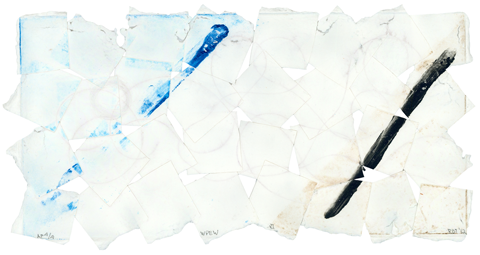 ‘when pressure exceeds weight vi’ Paper elements with embossment in three colors, 6 7/8 by 13 5/8 inches, by Richard Tuttle (Richard Tuttle/Universal Limited Art Editions) |
Richard Tuttle, who spends part of the year on Mount Desert Island, made his first important mark in the art world in 1967 with his “Octagonals”— shaped and dyed unstretched canvases. Since then, he has integrated painting, sculpture, drawing, artists’ books, site-specific installations, as well as other media, such as textiles and ceramics, into a highly varied, slightly eccentric, body of work. His pieces advance philosophical inquiries into the nature of art, specifically, the expressive and conceptual potential of an abstract language.
“Richard Tuttle: A Print Retrospective,” at the Bowdoin College Museum of Art, marks the first in-depth exploration of the role printmaking has played in the artist’s production. Spanning four decades and including over 100 works it is a sharp looking show that gives ample space to each portfolio and grouping.
Sometimes it even gets a little playful, in keeping with the experimental and colorful tone of the work, like running a wall label around a corner.
Tuttle’s other major contribution to the canon of contemporary art is his series of “Wire Pieces” from the early 1970s, of which a few pieces are in the show. Drawing a graphite line on the wall and attaching an irregularly bent wire to its end points, light supplies the third line in this composition as shadow. Already then, Tuttle explores delineation of space, and the creation of space becomes a recurring theme throughout his print oeuvre as well.
But let’s be clear—Tuttle is not a printmaker. Not in the sense most of us understand the term. He always works with professional printers to realize his vision, their role varying from executors to collaborators. Given the usual self-referential nature of Tuttle’s work, it comes as no surprise that the subjects of his prints are the defining characteristics of printmaking. Employing its potential for multiples, for interlacing processes, the use of a matrix in whatever form, the use of pressure for the transfer of an image, the role of paper—Tuttle’s experiments appear endless.
The exhibition is laid out in roughly chronological order, which allows for the detection of an arc from postminimalism to almost baroque painterliness, back to a conceptual approach. Both in his early and most recent work, the artist has made a conscious effort to involve the viewer/collector as an active participant (though of course not in a museum setting), reveling in the inherently democratic nature of printmaking. “In Praise of Economic Determinism” of 1973 incorporates two holes, a hand-drawn arching line on its recto, and on its verso lithographed instructions for hanging the print by its holes and for creating the line with string. “Temporary” of 2013–14 asks participants to recreate a specific arrangement of wooden cubes using a supplied stencil. In between these participatory end poles of Tuttle’s experiments with printmaking, he tries out new ideas for transforming images, blurs the line between paper as support and as the print itself (using paper pulp), and generally questions printmaking’s techniques, materials, and finality.